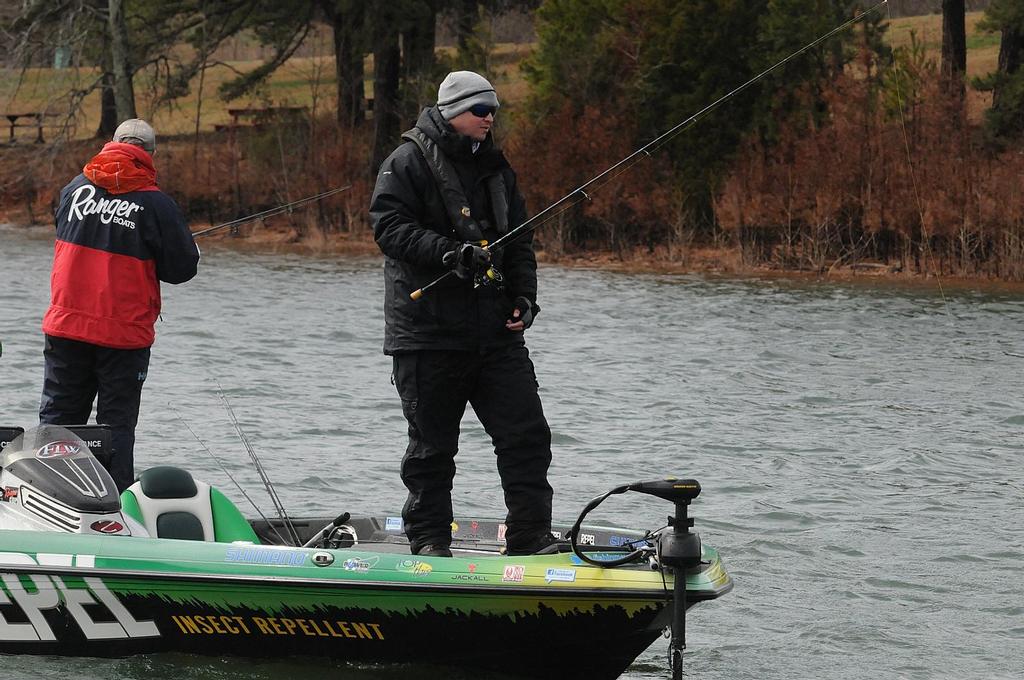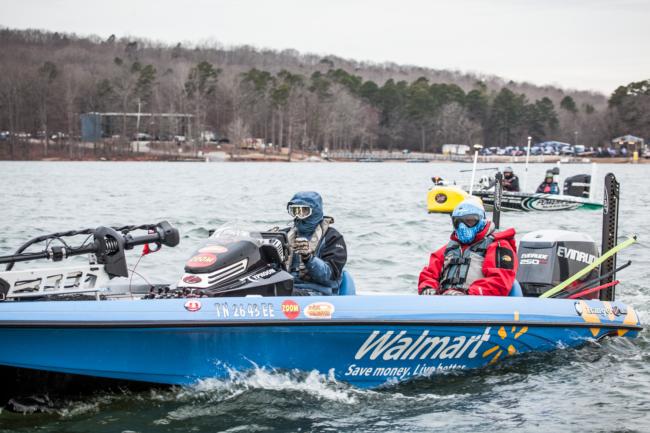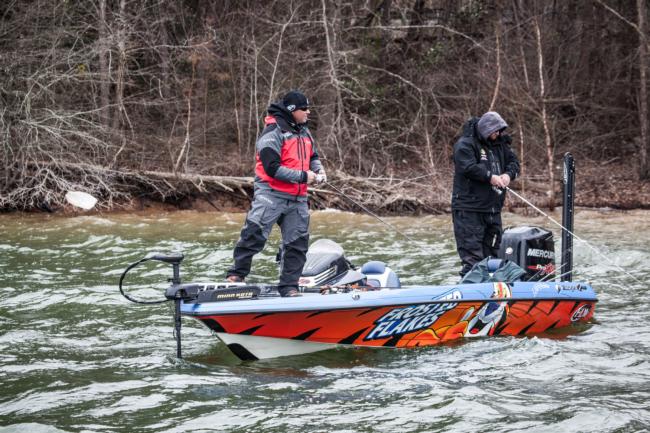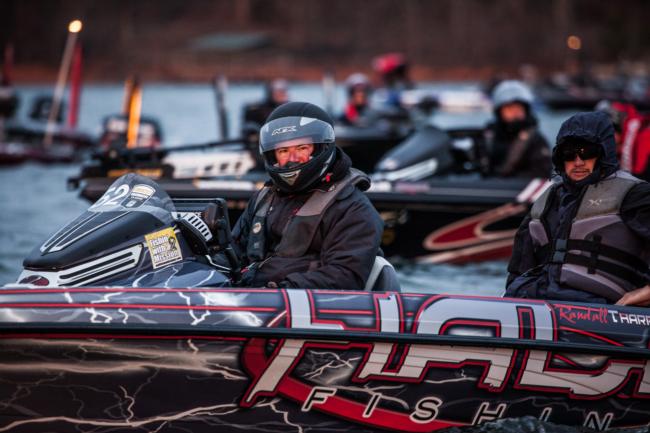The Chilly Truth
Busting those winter-fishing myths

(Editor's note: This article originally appeared in the 2013 Winter issue of Bass Fishing magazine. To read more compelling articles from Bass Fishing magazine each month, become an FLW subscriber member. If you'd like to sign up for a digital subscription to access articles online, click here).
Myths come in all shapes and sizes – and truths do too for that matter.
There’s the myth that a penny tossed off the top of the Empire State Building can penetrate the concrete sidewalk below (false). There’s also the myth that a duck’s quack doesn’t echo (true).
Not surprisingly, bass fishing has its own set of myths: Bass don’t eat topwaters when it’s sunny, big fish only eat big lures and so on. Winter fishing seems to take myths to a whole new level. Maybe the long hours in freezing cold numbs the mind as much as it does the hands, but one could write an article about how many myths there are regarding this chilly time of year – and whether or not they’re true.
So we did.
Myth: Fish will never hit a topwater in winter
Truth: A topwater approach is a prime way to target aggressive fish, which would seem to prove the myth, as winter bass are often lethargic. Still, bass are opportunistic feeders, especially large bass, and a meal on the surface is the easiest meal for a big bass in late winter.
Pro’s Comment: “This is completely false,” Walmart pro Wesley Strader says. “You don’t get many bites, but when you do it’s a good one. The conditions have to be right – late winter, water in the mid-40s, pre-frontal – but I’ve had some huge days throwing topwaters in winter.”
How to debunk the myth: Strader recommends a 1/4-ounce War Eagle buzzbait with an oversized blade. He usually creates his own by taking blades off larger buzzbaits and putting them on smaller ones. The reason behind this is he has to be able to reel the lure as slowly as possible, and the large blade and small body allow for it to creep along without sinking.
From there he heads to the backs of flats, where big females might be cruising even well in advance of the spawn. When conditions are as Strader describes, the bite can be on, though he says there is an easier way to know whether or not it’s the right conditions for a buzzbait.
“Bubbles,” Strader says. “When there is a bubble trail 4 to 5 feet behind my buzzbait, that’s when I know it’s the right pattern. I don’t know why, but the longer the bubble trail, left by the buzzbait, the bigger the fish I catch.”
Myth: Bass want slow-moving, subtle presentations
Truth: Cold water causes bass to slow down, as it will baitfish. That should mean that bass would not be willing to chase a lure. Yet, when using a reaction technique, you can get a bass to bite out of impulse, rather than hunger.
Pro’s Comment: “I fish all the way until we’re breaking ice at the ramp on Lake Erie,” Frosted Flakes pro Dave Lefebre says. “This is one of my favorite times to fish because you can catch 200 fish a day even with the water temperature in the 30s. The fish are keying on emerald shiners and smelt, and when you get a nice, sunny, pre-frontal day, you can almost power fish.”
How to debunk the myth: Lefebre’s two lures of choice to create a reaction bite in the winter are a Rapala Rippin’ Rap and a Heddon Sonar, both of which can be slow-rolled near the bottom and ripped out of cover.
The pattern revolves around flats inside bays, where lush weedbeds have since died off, leaving faint traces. Lefebre will count the lure to the bottom or to where he feels the tops of the remaining weeds are, and he’ll slow-roll it back to the boat. The second his lure hits any cover, he gives a quick snap of the rod tip.
“The bite is all reaction, just like what you’d see when guys do it over weed flats at Guntersville,” Lefebre says. “The difference is that the water is in the 30s. The fish don’t care. They still have to react.”
Myth: When the grass dies in winter, bass leave it.
Truth: Bass gravitate to vegetation because it provides cover, oxygen and food. When grass dies due to shorter periods of sunlight and low water temperatures in winter, the oxygen part goes away. In fact, decaying grass can actually deplete an area of oxygen. Yet, it still provides cover and perhaps food.
Pro’s Comment: “Most of the time, bass steer clear of sprayed or dead grass,” Randall Tharp says. “But when you get a severe cold front, especially in places like Florida and south Texas that are not used to seeing cold, those fish will go to that dead grass because it holds extra heat.
“The FLW Tour event on Okeechobee last spring was a prime example,” adds the 2013 Forrest Wood Cup champ. “I couldn’t catch a fish out of dead stuff for weeks. Then it got really cold during practice, and I could have caught four or five 30-pound bags a day from that stuff. Once it warmed back up for the tournament, they left, but for a couple days they were loaded in there.”
How to debunk the myth: This one might seem simple to debunk – just wait for a massive cold front and start flipping the dead, matted grass. But, there’s more to it.
For instance, the water temperature really has to drop. On a lake such as Okeechobee, Tharp looks for water temperatures in the 40s, though it can be different elsewhere.
Then it’s a matter of patience while flipping.
“You really have to leave the lure in a spot for a while,” Tharp says. “I’m talking like two minutes sometimes, which for a guy like me seems like an eternity. The fish will be so cold they’ll actually bump the lure with their mouths closed before actually eating it. You have to feel the bump and actually wait for the fish to pull the rod tip down a little before setting the hook.”
Myth: You can’t catch fish shallow in winter
Truth: Sure, plenty of bass do head deep in the winter, where water temperatures are more stable and can be higher than in the shallows. Yet certain shallows with the right characteristics will offer the warmest water, and that compels bass to feed more often.
Pro’s Comment: “This is the biggest myth that I’ve ever heard,” Terry Bolton says. “I catch a lot of fish shallow even when the water temperatures are in the low 40s and upper 30s in 2 feet of water. The shallows just have to be close to deep water.”
How to debunk the myth: Bolton seeks out 45-degree banks with deep water nearby. The other stipulation is that the banks have to have large chunk rock.
“The fish will always be around these areas because of how much heat those rocks hold [and subsequently stimulate the food chain from the bottom up],” Bolton says.
Other factors such as wind and sunlight also affect the water temperature on certain banks. For instance, chilly wind from a cold front blowing across an open basin can push cold water into a shoreline, while waves lapping against a bank in more typical weather can stir up sediment that causes the water to hold heat a little longer. And when the sun is lowest in the morning and evening, some banks will be shaded while others receive direct sunlight, depending on the terrain, trees lining the shoreline and the angle of the bank. It’s often best to target the sunniest banks in the morning, and to wait to fish shaded banks until later in the day, when the sun position has changed or the air temperature has risen.
To catch fish, Bolton ties on a Rapala Shad Rap, puts the nose of his boat almost on the bank and makes parallel casts to the bank, slowly reeling in his lure. This allows him to keep the crankbait in the shallow strike zone throughout the entire retrieve, while also determining if the fish are right against the rocks or holding just off of them.
Myth: You can’t catch fish in cold muddy water
Truth: When it rains in winter, it’s certainly not a warm rain. That means the runoff is going to drop the water temps in the creeks, and it’s also going to muddy up the water. Also, in reservoirs, there’s usually less man-made current, so muddy water can hang around for weeks. That’s a bad situation for the first couple days after the rain, but eventually the sediment in the muddy water will heat up enough that it will attract bass out of clearer areas.
Pro’s Comment: “That’s extremely false,” says Arkansas pro Spencer Shuffield with emphasis. “When it’s fresh, muddy water, there’s some truth to that. But after a couple days, especially some sunny days, that water is really going to warm up. It’s like in the winter, when you’re out of the wind and standing in the sun; it feels warm, even if the temperatures are below freezing. Same deal with the muddy water.”
How to debunk the myth: A few days after a rain, Shuffield will head toward secondary points with rock on them, near channel swings. The rock, combined with the suspended particles, will warm the water and can create some great fishing.
Once there, he’ll start with a Rapala DT6 in hot mustard or slow-roll a 1/2-ounce spinnerbait with large Colorado blades to try and determine if there are any active fish on those points. He’ll also move into the backs of the creeks, fishing anywhere in the middle that is 8 feet deep or shallower, depending on if he finds baitfish there.
“If I see the bait flickering in the middle of the creek arm and not on the points, or vice versa, then that’s where I’m going to start searching in that muddy water,” Shuffield says.
Regardless of where he finds the bass, he’ll often switch to a black-and-blue jig and pick the area apart to catch the fish that are not as active.
Ditches and Baitfish
Whether an angler fishes shallow or deep, fast or slow in the winter, the two things every pro queried for this story mentioned were the need for baitfish and deep water to be nearby.
“The baitfish use those ditches to navigate in and out of deep water,” Shuffield says. “I’ve seen where the balls of bait are only 5 feet down over 20 feet, but they will be directly over the ditch. I don’t know how they know, but they do. Usually the difference between good winter creek arms and bad ones is which ones have the deep ditches leading in and out of them.”


